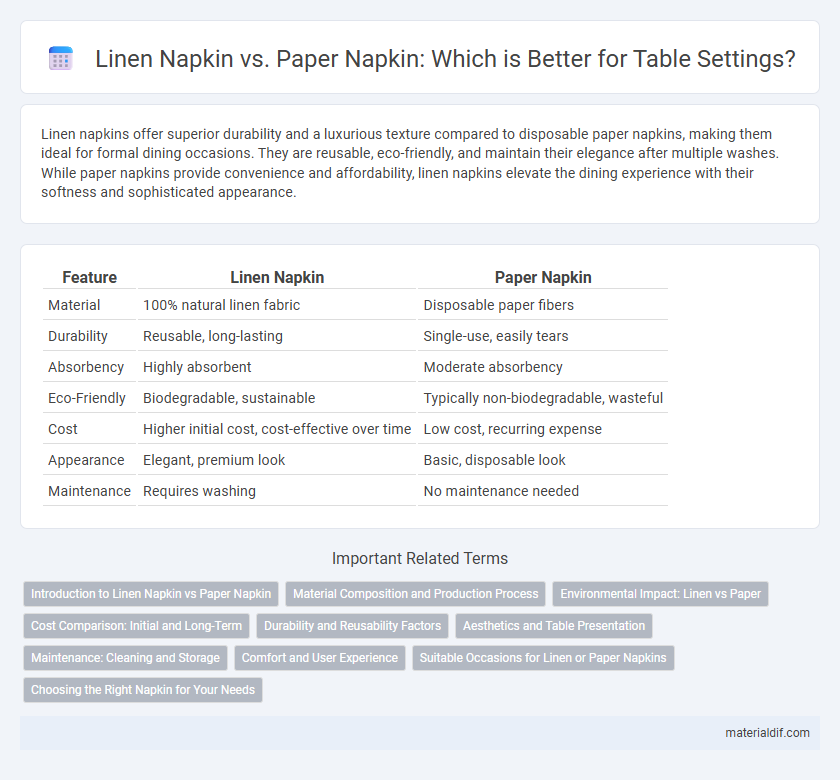Linen napkins offer superior durability and a luxurious texture compared to disposable paper napkins, making them ideal for formal dining occasions. They are reusable, eco-friendly, and maintain their elegance after multiple washes. While paper napkins provide convenience and affordability, linen napkins elevate the dining experience with their softness and sophisticated appearance.
Table of Comparison
| Feature | Linen Napkin | Paper Napkin |
|---|---|---|
| Material | 100% natural linen fabric | Disposable paper fibers |
| Durability | Reusable, long-lasting | Single-use, easily tears |
| Absorbency | Highly absorbent | Moderate absorbency |
| Eco-Friendly | Biodegradable, sustainable | Typically non-biodegradable, wasteful |
| Cost | Higher initial cost, cost-effective over time | Low cost, recurring expense |
| Appearance | Elegant, premium look | Basic, disposable look |
| Maintenance | Requires washing | No maintenance needed |
Introduction to Linen Napkin vs Paper Napkin
Linen napkins offer superior durability and absorbency compared to paper napkins, making them ideal for formal dining and eco-friendly use. While paper napkins provide convenience and single-use practicality, linen napkins enhance table aesthetics with their elegant texture and reusable nature. Choosing linen napkins reduces waste and promotes sustainability, distinguishing them from the disposable qualities of paper alternatives.
Material Composition and Production Process
Linen napkins are crafted from natural flax fibers, which undergo harvesting, retting, and weaving to create durable, eco-friendly fabric with high absorbency and breathability. Paper napkins are made primarily from wood pulp through pulping, bleaching, and pressing, resulting in a disposable product with lower strength and environmental impact compared to linen. The production process of linen involves labor-intensive textile manufacturing, while paper napkins rely on mass production techniques suitable for single-use applications.
Environmental Impact: Linen vs Paper
Linen napkins have a significantly lower environmental impact compared to paper napkins due to their reusability and biodegradability, reducing waste in landfills. The cultivation of flax for linen requires fewer pesticides and less water than the production of paper from wood pulp, which often involves deforestation and chemical processing. Linen's durability extends its lifecycle, making it a sustainable choice that minimizes resource consumption and carbon footprint over time.
Cost Comparison: Initial and Long-Term
Linen napkins have a higher initial cost due to fabric quality and manufacturing but offer long-term savings through reusability and durability, reducing frequent replacements and waste. Paper napkins incur a lower upfront expense but result in continuous costs for regular repurchasing and disposal. Over time, investing in linen napkins proves more economical for businesses seeking sustainable and cost-effective dining solutions.
Durability and Reusability Factors
Linen napkins offer superior durability compared to paper napkins, with fibers that withstand repeated washing without losing texture or integrity. Their reusability significantly reduces waste, making linen an eco-friendly alternative that maintains quality over time. Paper napkins, often single-use and prone to tearing, lack the longevity and environmental benefits inherent in linen options.
Aesthetics and Table Presentation
Linen napkins elevate table presentation with their rich texture, natural sheen, and elegant drape, creating a sophisticated dining atmosphere unmatched by paper alternatives. The durable fabric resists wrinkles and stains, maintaining a pristine appearance throughout the meal, unlike disposable paper napkins which can look flimsy and detract from upscale settings. Investing in high-quality linen napkins enhances aesthetic appeal and reflects attention to detail in formal dining arrangements.
Maintenance: Cleaning and Storage
Linen napkins require gentle washing with mild detergents and air drying to maintain their texture and durability, while paper napkins are disposable and require no cleaning. Proper storage of linen napkins involves folding and placing them in a dry, ventilated area to prevent mildew and fabric damage. In contrast, paper napkins are stored in moisture-free packaging and discarded after use, eliminating long-term maintenance concerns.
Comfort and User Experience
Linen napkins offer superior comfort due to their soft, breathable fabric that feels gentle on the skin, enhancing the dining experience with a touch of luxury. Unlike paper napkins, which can be rough and prone to tearing, linen napkins provide durability and absorbency, making them more effective for cleaning and wiping. The reusable nature of linen napkins also contributes to a more sustainable and pleasant user experience compared to single-use paper alternatives.
Suitable Occasions for Linen or Paper Napkins
Linen napkins are ideal for formal events such as weddings, upscale dinners, and holiday celebrations due to their elegance and durability. Paper napkins suit casual occasions like picnics, fast food meals, and informal gatherings because of their convenience and disposable nature. Choosing linen enhances the dining experience with a refined touch, while paper napkins provide practicality for everyday use.
Choosing the Right Napkin for Your Needs
Linen napkins offer superior absorbency, durability, and a luxurious feel compared to paper napkins, making them ideal for formal dining or special occasions. Paper napkins provide convenience and disposability, suitable for casual meals and events requiring quick cleanup. Selecting the right napkin depends on factors like event formality, budget, environmental impact, and desired user experience.
Linen Napkin vs Paper Napkin Infographic

 materialdif.com
materialdif.com